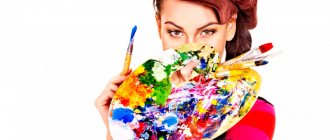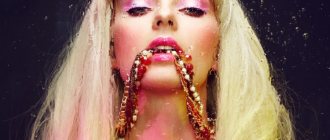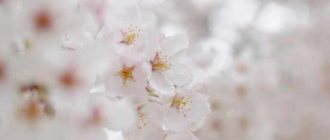Physiology of color perception
The ability to distinguish colors is not inherent in us from birth. A newborn baby has contrast vision: he distinguishes between light and dark. The next stage is noticing movements, then shapes and outlines, and lastly, beginning to distinguish colors.
Getting on the receptors of the eye retina - cones (responsible for color and black-and-white vision) and rods (responsible for black-and-white vision), color photons cause their excitation and inhibition, thus transmitting information to the brain.
The retinal receptors responsible for color vision (cones) in humans and primates have a certain type of light-sensitive pigment that allows them to distinguish colors:
- blue;
- red;
- green.
Thomas Young experimentally showed at the beginning of the 19th century that all visible colors of the spectrum can be obtained by mixing these three colors.
The physiology of color perception is associated with the higher and primitive areas of activity of the cerebral cortex. The functions of perception, discrimination and the ability to name colors are the results of human development, and not instinctive reactions, and are therefore controlled by the higher areas of the cerebral cortex. Primitive areas of the brain control reflex reactions to color (light and dark).
Double Impact
It is a generally accepted fact that the perception of color is accompanied by a strong emotional impact. This problem was studied in detail by painters. V. V. Kandinsky noted that color affects a person in two ways. First, the individual experiences a physical effect when the eye is either fascinated by the color or irritated by it. This impression is fleeting when it comes to familiar objects. However, in an unusual context (an artist’s painting, for example), color can evoke a strong emotional experience. In this case, we can talk about the second type of influence of color on an individual.
Psychology of color perception
Color perception is biased, since the preference for one color or another is influenced by many factors:
- age;
- life experience;
- profession;
- health status;
- place and living conditions;
- mental condition;
- belonging to a certain culture;
- brightness, saturation, color change rate;
- background color, neighboring objects, lighting.
In each specific situation, be it the choice of the color of an outfit, interior, car, we are guided by additional factors: whether the outfit will be in harmony with other details of clothing, whether the color of the interior matches the residential purpose of the room, and so on. The choice is entirely conditional.
Disputes about which color is better are meaningless, since each individual perceives colors through the prism of their own subjective experience. To make it clear why this happens, let us turn to the origins of the origin of humanity. Then two factors were decisive for life on earth: day and night, light and darkness. At night, a person stopped engaging in vigorous activity and instinctively devoted this time to rest, sleep, and recuperation. All processes in the body, in particular the work of the endocrine glands, slowed down. The day brought with it the opportunity for active action (getting food, building a home). Metabolism, the work of glands intensified, the influx of energy pushed me to take active action.
Sympathy for a particular color is determined by the characteristics of the brain and the functioning of body systems at a certain period of life.
To make it clear what meaning each color has, which reflects favor towards some colors and rejection of others, let us turn to the research of Swiss psychologist Max Lüscher.
Initially - white
What a blessing that we see the world in color! Without this, life would be boring and dull. However, a person does not immediately acquire color vision. The colored world opens up to the child in a certain sequence. First he perceives red, orange, yellow and green, and only then violet, blue and cyan. This may be because each color in the solar spectrum has a different wavelength.
White color occupies a special place. It is perceived as the color of absolute purity and, considered a symbol of something abstract, visually signifies emptiness. Please note: we perceive these black letters on a white background as an object in an impersonal, empty two-dimensional space. White color for artistic purposes can only be used when it is located between two aggressive tones or when it is used to decorate some surface that should attract attention (signs, warnings, advertising). White guide lines on a black or dark road background prevent traffic disruption, as they best attract the driver's attention. When you need to highlight the most important color, such as a fire-red fire sign, the optimal background for it is white.
Luscher color test
Psychologist Max Luscher studied the phenomenon of visual perception for a long time. As a result, data were obtained on the direct relationship between the psychological state of an individual and the most preferred colors. Luscher created a unique method of color diagnostics. It was called the Luscher test.
Let's talk in general terms about a simplified, but quite informative, version of the test.
The test is carried out by laying out cards painted in eight different colors according to the principle of decreasing liking for colors. The cards are assigned serial numbers:
- primary colors : blue (1), green (2), red (3), yellow (4);
- auxiliary : purple (5), brown (6), black (7), gray (0).
When taking the test, you need to distract yourself from the relationship of colors with each other. Perceive only the color itself abstractly, without any assessments, do not think about whether you like clothes of this color, whether similar tones are acceptable in the interior.
This procedure is carried out twice. When making a choice a second time, you don’t need to think or remember which tones were chosen earlier. This will result in two rows of numbers that need to be written down in order of preference. Based on the data obtained during the test, a person receives a comprehensive analysis of his personal psychological state.
Interestingly, the Luscher color test is sometimes used as an auxiliary diagnostic method when making a medical diagnosis; it can warn of the occurrence of painful conditions: heart failure, compression of cerebral vessels, malfunctions of the gastrointestinal tract.
The objectivity of the test is determined by the perception of color through contrasts. So, if the body is subject to excessive stress, needs peace, tranquility, emotional and physical rest, stress relief, the choice will instinctively fall on darker colors. If there is a desire for energetic activity, creativity, the result of the choice will be brighter tones.
Colorblindness (the inability to distinguish one or more colors) does not prevent you from taking the test and obtaining reliable results.
The colors for the test were carefully selected based on psychological and physiological meaning. This data is universal for any person. The main condition is a clear understanding of how the diagnosis is carried out: the subject must arrange the colored cards in order of their preference on an intuitive level.
Interpretation of test results is carried out based on the transcript:
- place (order) of each card;
- the meanings of the selected colors;
- values of the color ratio in pairs of cards that are in the same position for each choice (for example,
- with the first choice, green took the leading place, and with the second, yellow).
People taking the test are often shocked that simply laying out colorful cards can reveal such a deep psychological state.
Other associations.
Colors are also endowed with other properties, mainly due to natural associations. The cultural or individual properties of color are very varied and almost endless.
Dry: yellow, orange, red. Wet: blue, blue, green.
A simple associative series operates here. Sun, sand, fire cause warmth and dryness. Water, clouds, plant leaves are wet.
Cool, light and muted shades are perceived as liquid or transparent, these are the colors of air and water.
Warm, dark and rich shades appear dense, dense and opaque.
Sunny colors: light, warm, rich. Shadow colors: dark, cold, desaturated.
Fresh colors: blue, turquoise, yellow, lemon.
Color associations are numerous, and contrasts in properties are widely used. For example, in painting, emotions and mood are often conveyed using color associations.
Continued: color types >>
Brief meaning of card positions
The color of the very first card in each row means the method of moving towards the goal, the state in which a person strives to achieve what he wants. For example, if the color blue comes first, then the main method is peace and tranquility.
The second position is the true goal, what a person strives for.
The third and fourth places reflect the situation and circumstances of the current period of life at the time of testing.
The fifth and sixth cards represent indifference; their meaning is not rejected, but has no place in the current situation.
The seventh and eighth are hostility, rejection, antipathy, forcedly suppressed needs.
Nature around us
Probably, the article could start from this point, because nature is the main source of bright colors and colors. But, at the same time, for a city dweller in the middle zone this is not always the case.
And if summer still gives us enough flowers, then in winter it begins to seem that there is simply nowhere to get them from. Of course, the main rule is to just periodically travel outside the city or go for a walk in the park: in any case, you will see new shades, the play of light and shadow. Even the sky will be its own color every time, a little different than yesterday.
Take advantage of the good clear weather: if it's a nice day, sacrifice house cleaning and go for a walk in nature.
Don't forget about the benefits of sunlight. Mood and color are interconnected - and you will definitely feel it in practice. In addition to walks, you can also think about TV shows on relevant topics, as well as such non-standard “meetings” with nature, such as visiting a zoo, an aquarium or a botanical garden (greenhouse).
The meaning of eight colors
Each of the eight colors has a specific meaning; below are brief characteristics.
Blue color
This color symbolizes the depth of feelings, peace, and concentration. People who choose blue are sensitive, receptive, and want integrity. They care about love, tenderness, and mutual affection. This is the color of fidelity, it promotes philosophical reflection and concentration. It’s not for nothing that you can endlessly look at the sea. Rejection of the color blue indicates unsatisfied emotional needs and a suppressed desire for peace.
Green color
Green indicates flexibility of mind. Its psychological components: stubbornness, perseverance, resistance to change, self-confidence. People who choose green are firm in their opinions and true to their principles. It is important for them to strengthen their own importance, self-respect, and dominance over others.
Red color
This color symbolizes willpower, blood, fire, masculinity. Embodies desires, passionate aspirations. Has a stimulating effect on the nervous system. Raises blood pressure, enhances the functioning of the endocrine system.
Rejection of red expresses irritation from a lack of vital energy, hostility to excited activity. This may be due to physical weakness, fatigue or heart failure.
Yellow
Yellow color is spontaneity, spontaneity, a source of bright joy and cheerful optimism. Those who prefer yellow tend to strive for happiness, hope, and impulsiveness. The expectation of happiness manifests itself in various forms: from intimate adventure to spiritual quests that culminate in enlightenment. If the yellow color is denied, then this is a clear indication that hopes and desires have collapsed, and the person feels alienated.
Purple
Purple color is a combination of red and blue. Presented as a separate color that combines the impulsive passion of red and the deep tranquility of blue. A person who likes the color purple believes in miracles, expects magic, wants to make impressions, wants to evoke admiration. Preserves childlike spontaneity into adulthood. It is not for nothing that after babies learn to distinguish colors, they choose purple from the multi-colored toys offered to choose from.
Brown color
This color signifies the importance of physical perception. The choice of brown indicates that a person has certain physical ailments, problems, the inability to ensure his own safety, and a feeling of anxiety. There is a desire to get rid of problems that cause physical discomfort.
When the Luscher test was administered to people who had gone through the war, most of them preferred brown due to psychological decline and health problems.
Black color
Black embodies the rejection of color. Black color is “no”, the cessation of life, destruction. People who put black first on the list of their preferences reject everything, protest, proclaim that they are not satisfied with the established order of things. Rebellion is their way of life. Here it is appropriate to recall the movement called “goths”, who deny rules and conventions, dress in black, and do not recognize other colors.
Grey colour
This color symbolizes neutrality. It is neither light nor dark, neither bright nor pale. He is nobody's, psychologically neutral. People who have chosen the gray color and put it first want to protect themselves from the outside world, want no one to interfere in their lives. When solving their own problems, they take an observant position.
The psychology of perception is a subtle, complex, but incredibly interesting science. External sense organs receive signals from outside and send them to the brain. The brain at the reflex level (automatically) correlates received signals with the internal state of the body, processes information, and produces results. Thus, knowing what colors a person likes, you can easily analyze not only his internal psychological state, but also his physical health.
Story.
Interest in the study of color arose when primitive people learned to extract and make natural paints. From this point on, colors were inextricably linked with magic and religion. The importance of knowledge about color perception and the need for its application in various fields of science was discussed back in Antiquity. In his writings, the ancient Greek physician Empedocles identified each element with a separate color. And the founder of philosophy, Aristotle, compared the color scheme to musical harmonies.
Do you want to make better decisions, find your ideal career, realize your maximum potential and receive instructions for individual development?
?
All this can be done using the Human Design
. Build your map and get basic transcripts for free.
The principles of the influence of color on the human psyche have always been of interest to artists and architects . The first to create a harmonious system of color perception and identify six basic colors was Leonardo Da Vinci . He also introduced the concept of color contrast, paired shades, and also noted that the perception of white depends on the environment. In the 15th century, the Italian painter Gian Paolo Lomazzo compared color shades with different temperaments.
, Isaac Newton's achievements in physical optics almost stripped color of its theological content. One of the first to talk about the relationship between “individual colors and special mental states” was the German poet Goethe . After several decades of work, he published the book “The Teaching of Color,” which he himself valued higher than his poetic achievements. Later, scientists started talking about the healing properties of color. Thus, the great Russian psychiatrist Bekhterev argued that “an attractive color scheme heals better than any medicine...”.











